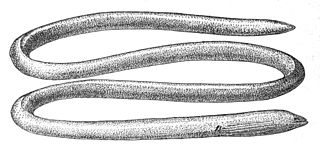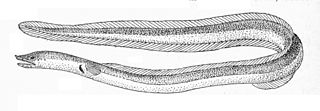
Moringua is a genus of eels of marine ray-finned fishes belonging to the family Moringuidae, the spaghetti eels. These eels occur in shallow tropical and subtropical waters.
The short worm eel is an eel in the family Moringuidae. It was described by Pieter Bleeker in 1863, originally under the genus Aphthalmichthys. It is a tropical marine eel found in the Indo-Pacific, including Laccadives, the Ryukyu Islands, the Philippines, the Marshall Islands, Samoa, and Indonesia. It is known to inhabit reefs. Males can reach a maximum total length of 33 cm.
The Bengal spaghetti-eel is an eel in the family Moringuidae. It was described by John McClelland in 1844, originally under the genus Ptyobranchus. It is a tropical eel known from estuaries in the Ganges River, between India and Bangladesh. Males can reach a maximum total length of 65 cm.

Moringua bicolor, the bicolor spaghetti eel, is an eel in the family Moringuidae. It was described by Johann Jakob Kaup in 1856. It is a marine eel known from Japan, Indonesia, the Philippines, and the Laccadive Sea, in the Indo-West Pacific. It dwells in temperate waters at a known depth of 3 m (9.8 ft).

Moringua edwardsi, the common spaghetti eel, is an eel in the family Moringuidae. It was described by David Starr Jordan and Charles Harvey Bollman in 1889, originally under the genus Stilbiscus. It is a subtropical, marine eel known from the western Atlantic Ocean, including Antigua and Barbuda, Aruba, the Bahamas, Barbados, Belize, Bermuda, Cuba, Dominica, Grenada, Guadeloupe, Honduras, Jamaica, Martinique, Mexico, Montserrat, Nicaragua, Puerto Rico, Saint Kitts and Nevis, Saint Lucia, Saint Vincent and the Grenadines, Trinidad and Tobago, Florida, Venezuela, the Virgin Islands, British, and the Virgin Islands of the United States. Males can reach a maximum total length of 15 cm, while females can reach a maximum of 50 cm. The eels feed primarily off of burrowing invertebrates.
The rusty spaghetti eel, also known as the rusty worm eel, the slender worm eel, or the intermediate thrush-eel is an eel in the family Moringuidae. It was described by Richard Bliss Jr. in 1883. It is a tropical, marine eel which is known from the Indo-Pacific region, including East Africa, Easter Island, the Ryukyu Islands, Australia, and Micronesia. It leads a benthic lifestyle, burrowing into sandy regions in reefs at a depth range of 1–40 m. Males can reach a maximum total length of 140 cm.

The Java spaghetti eel, also known as the Java thrush-eel, Java worm eel, and the black-tailed thrush eel is an eel in the family Moringuidae. It was described by Johann Jakob Kaup in 1856, originally under the genus Aphthalmichthys. It is a tropical, marine eel which is known from the Indo-Pacific, including East Africa, the Tuamoto Islands, the Ryukyu Islands, and Micronesia. It is a burrowing species which inhabits reefs at a depth range of 2–15 m. Males can reach a maximum total length of 120 cm.
Moringua macrocephalus is an eel in the family Moringuidae. It was described by Pieter Bleeker in 1863, originally under the genus Aphthalmichthys. It is a subtropical, freshwater eel which is known from rivers in the east and south China Sea. It typically dwells in river mouths and mud flats. Males can reach a maximum standard length of 36.5 centimetres.
Moringua macrochir, the longfin spaghetti eel, is an eel in the family Moringuidae. It was described by Pieter Bleeker in 1855. It is a tropical, marine and freshwater eel which is known from Batu Island, Indonesia, and Christmas Island, in the eastern Indian Ocean.
Penn's thrush eel is an eel in the family Moringuidae. It was described by Leonard Peter Schultz in 1953. It is a tropical, marine eel which is known from Papua New Guinea, in the western central Pacific Ocean.
The purple spaghetti-eel is an eel in the family Moringuidae. It was described by Francis Buchanan-Hamilton in 1822, originally under the genus Muraena. It is a tropical eel known from India, Bangladesh, Nepal, Indonesia, and the Philippines. It inhabits rivers and estuaries, and has adapted to rapid and wide changes in salinity, pH, and osmoregulatory and hypoxic conditions. Males can reach a maximum standard length of 44 cm.
The Maimed snake eel is an eel in the family Ophichthidae. It was described by Pieter Bleeker in 1857. It is a marine, tropical eel which is known from the Indo-Pacific, including the Red Sea, East Africa, Samoa, the Ryukyu Islands, Australia, and Micronesia. It dwells at a depth range of 1 to 13 metres, and inhabits coral reefs and lagoons, where it forms burrows in soft benthic sediments. Males can reach a maximum total length of 24 centimetres (9.4 in), but more commonly reach a TL of 8 centimetres (3.1 in).

The ordinary snake eel is an eel in the family Ophichthidae. It was described by Pieter Bleeker in 1864, originally under the genus Echelus. It is a marine, tropical eel which is known from the Indo-Western Pacific, including Vietnam, Japan, Fiji, the Marshall Islands, and Australia. It inhabits sandy sediments. Males can reach a maximum total length of 39 centimetres.
The Indo-Pacific slender worm-eel is an eel in the family Ophichthidae. It was described by Pieter Bleeker in 1857. It is a marine, tropical eel which is known from the Indo-Pacific, including the Red Sea, East Africa, the Line Islands, the Society Islands, Johnston Island, Japan, Rapa Iti, Micronesia, and the southern Great Barrier Reef. It forms burrows in inshore sediments of loose gravel and sand. Males can reach a maximum total length of 38 centimetres (15 in).
The slender snake eel is an eel in the family Ophichthidae. It was described by Pieter Bleeker in 1857. It is a marine, tropical eel which is known from the Indo-Pacific, including East Africa, the Society Islands, the Ryukyu Islands, and the Great Barrier Reef. It dwells at a depth range of 30 to 33 metres, and inhabits sand sediments, tidepools and swamps in mangroves. Males can reach a maximum total length of 25 centimetres (9.8 in).
The bigfin snake eel is an eel in the family Ophichthidae. It was described by Pieter Bleeker in 1853. It is a tropical, marine eel which is known from the Indo-Pacific. It dwells at a depth range of 0–25 metres, and inhabits sand and mud. Males can reach a maximum total length of 92 centimetres.

The many-eyed snake eel is a species of eel in the family Ophichthidae. It was described by Pieter Bleeker in 1864. It is a tropical, marine and freshwater-dwelling eel which is known from the Indo-Pacific, including East Africa and the Hawaiian Islands. It dwells at a depth of 2 to 25 metres, and inhabits sand and rubble sediments near coral reefs. Males can reach a total length of 62.5 centimetres (24.6 in).

The olive snake eel is an eel in the family Ophichthidae. It was described by Pieter Bleeker in 1853, originally under the genus Ophisurus. It is a marine, tropical eel which is known from the Indo-Pacific. It forms burrows in soft sediments in shallow waters, and leads a nocturnal lifestyle. Males can reach a maximum total length of 95 centimetres (37 in).
Hoeven's snake eel is an eel in the family Ophichthidae. It was described by Pieter Bleeker in 1853, originally under the genus Ophisurus. It is a marine, tropical eel which is known from three specimens found in the Indo-Western Pacific, including Sulawesi, Indonesia, the Persian Gulf and the Gulf of Oman. It is known to inhabit shallow water and lagoons. Males are known to reach a total length of 22 centimetres (8.7 in).
The earthworm snake-eelYirrkala lumbricoides, is an eel in the family Ophichthidae. It is a tropical, marine eel which is known from the Indo-Pacific. It is known to dwell at a depth of 20 metres. Males can reach a total length of 44 centimetres.





